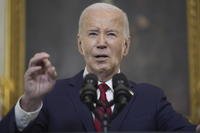The slugfest over the V-22 Osprey swung into round 10 or so today as Rep. Edolphus Towns (D-NY), chairman of the House Oversight and Government Reform Committee, called for a halt to V-22 production. The Marines defended the plane, including the remarkable claim by the head of Marine Aviation that US foreign policy would be fundamentally different today if the V-22 had been available in 1980 when the US tried and failed to rescue the hostages held in the US Embassy in Iran.
"It would have been a successful mission and we probably wouldn't be where we are with Iran today," Lt. Gen. George Trautman said in response to a "softball" question from the top Republican on the House Oversight and Government Reform Committee. Rep. Issa asked Trautman what would have happened if the V-22 had been available back then.
But the chairman said "it's time to put the Osprey out of its misery," adding that, "the dream of a viable high-speed, long-range, tilt-rotor aircraft has not been realized."
It was about as wild as a defense procurement hearing gets. There were charges of blatant untruths and ignorance and more reasoned dialogue about operational readiness rates and life cycle costs.
Bottom lines. For the Marines, Trautman said the plane saves lives because it can do things no helo can handle. Lt. Col. Karsten Heckl, former VMM-162 commander in Iraq, said his aircraft flew everywhere and everywhen it was asked, including into the most dangerous areas in broad daylight. "I operated for seven months and did not miss a mission. I don't know what else you want," Heckl told the committee. For the House committee: "The Marine Corps’ own reports on the performance of the Osprey in Iraq reveal that the Osprey was restricted to a very limited role due to its vulnerability to hostile fire, its lack of maneuverability, and its unreliability in the heat and sand of Iraq."
That was the heart of Towns' opening statement as he faced Trautman, back from last month's aborted hearing.
The chairman did not let up. Towns said the combat readiness rate for the Ospreys was "surprising and appalling." Of the 105 Ospreys bought since 1988, he said, "only 47 are considered 'combat deployable.' Worse, we asked the Marine Corps how many of these are ready for combat on any given day. On the day the Marine Corps picked, June third of this year, only 22 of these 47 Ospreys were ready for combat. In other words, fewer than half could be used for combat on a good day."
Towns' was drawing on the latest GAO report about the V-22, which makes for occasionally grim reading. One statistic sure to draw close scrutiny from the House and Senate as they mark up the defense spending and authorization bills is a new estimate for the long-term costs of the tilt-rotor aircraft: "The aircraft’s operations and support costs, currently reported at $75.4 billion (then-year dollars) for the life cycle of the program, are just beginning and expected to rise. The MV-22’s costs per flight hour is over $11,000—more than double the target estimate and 140 percent higher than the CH-46E helicopter."
The man who, until recently was the lead analyst on the MV-22 at the respected Institute for Defense Analyses, went much further. Arthur Rivolo criticized the V-22 as a dangerous aircraft, saying the V-22 "would fail to meet basic airworthiness requirements" set by the FAA. The Marines' commitment to the aircraft "represents a cynical disregard for soldiers' lives in favor of supporting a blind allegiance to the cause of this aircraft."
Those claims led an outraged Lt. Col. Heckl to counterattack: "Some of what I've heard here today is just blatantly inaccurate. I don't agree with a single thing Mr. Rivolo said.
Trautman didn't answer Rivolo's claims. He focused on the mean time between failures for Osprey parts, citing them as the biggest problem the plane faces and the main cause of the sharply rising life cycle costs.
The GAO report recommended a fundamental rethink of the Osprey program. "Questions to consider include: To what degree is the V-22 a suitable and exclusive candidate for the operational needs of the Marine Corps and other services? How much will it cost? How much can DOD afford to spend? To what degree can a strategy be crafted for ensuring control over these future costs? If the V-22 is only partially suitable, to what degree can another existing aircraft or some mixture of existing aircraft (including V-22s) or a new aircraft perform all or some of its roles more cost effectively? Some consideration should be given to evaluating the roles such aircraft play in today’s theaters of war and whether their performance warrants their cost," the GAO said.
What's at stake? "Failure to re-examine the V-22 program at this point risks the expenditure of billions of dollars on an approach that may be less effective than alternatives."
Round 11 coming up soon.








